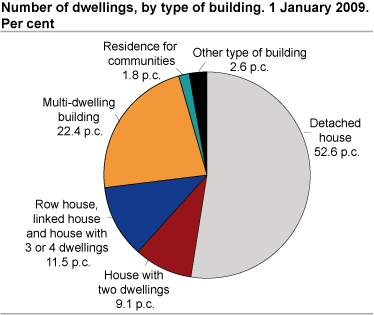Content
Published:
This is an archived release.
2.3 million dwellings
The number of dwellings has passed 2.3 million. The number of dwellings has increased by 86 000 in the last three years, of which 60 per cent are in multi-dwelling buildings.
There were a total of 2 300 739 dwellings in Norway as at 1 January 2009, with more than half (1 211 431) being in detached houses. Flats in multi-dwelling buildings followed with 514 481, while there where 264 304 dwellings in row houses, linked houses and houses with three or four dwellings. There were 209 873 dwellings in houses with two dwellings and 40 995 dwellings in residences for communities. The remaining 59 665 dwellings are registered in buildings where the main part of the floor space is used for purposes other than dwellings, mainly industrial buildings.
Largest increase in urban settlements
In 2008, the number of dwellings in urban settlements increased by about 34 000 dwellings, first and foremost due to an increase in the number of flats in multi-dwelling buildings in urban settlements, but also due to changes in delineations of urban settlements. The number of dwellings in sparsely built-up areas decreased by 7 000.
Unequal standard of dwellings
Dwelling stock statistics also show different indicators for quality of dwellings, in terms of number of rooms, baths, toilets and utility floor space of dwellings. Figures show that about half of the dwellings only have one toilet. There are however great differences. While nine out of ten dwellings in multi-dwelling buildings only have one toilet and one bath, dwellings in detached houses have a much higher frequency of more than one toilet and bathroom. A total of 46 per cent of dwellings in detached houses have more than one toilet, and 29 per cent more than one bathroom.
Figures also show differences in dwellings with respect to utility floor space and number of rooms. While half of the dwellings in detached houses have 4 rooms or more, only every fifth flat in multi-dwelling buildings has more than 4 rooms. Two thirds of flats in multi-dwelling buildings have less than 80 square metres of utility floor space, whilst only one in ten dwellings in detached houses are smaller than 80 square metres.
More figures are available at StatBank .
Comparability with the Housing Census in 2001The register-based dwelling statistics cannot be compared directly with the Housing Census in 2001 . The Housing Census covered 1.96 million occupied dwellings, while the statistics on the dwelling stock include all dwellings, both occupied and vacant. Improvement of the GAB register/MatrikkelenThe municipalities are cleaning up their registers to improve the quality. This is being done continually and also especially in connection with the transition to the new official building register, “Matrikkelen”. Dwellings that were incorrectly classified the previous year may have been assigned the correct information the following year. The number of registered dwellings in the municipalities may also change from year to year because of the clean up. As a result, the number of dwellings in some of the municipalities may not be directly comparable with the previous year. Extension of the statisticsThe plan is then to extend the statistics with more information about the dwellings. In the future it is also the plan to distinguish between occupied and vacant dwellings. More about comparability, quality and other information can be found in “About the statistics” . |
Contact
-
Jens Mathiesen
E-mail: jens.mathiesen@ssb.no
tel.: (+47) 40 81 13 98
-
Mona Takle
E-mail: mona.takle@ssb.no
tel.: (+47) 40 81 14 12


